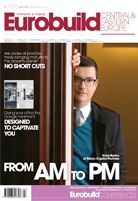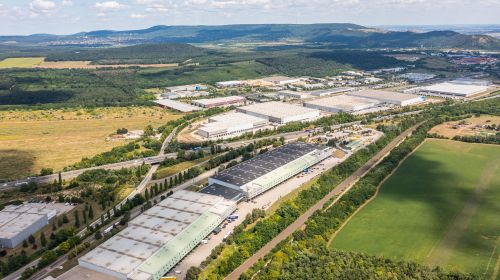Designed to captivate you
Interior DesignWhat is the ideal workplace? In the last few years the model for this has been the offices of internet giant Google. Desks made out of surfboards, workrooms located in fairytale Cinderella coaches, playrooms, gyms, huge canteens and spas - all are provided for the thousands of programmers, who sometimes do not leave the office for a few days at a time. Such offices have set design trends all over the world, and the huge furnishing budgets for them have made it possible to realise designers' most outlandish visions. But is it actually only about the design? We put this question to Stefan Camenzind, a partner and the general director of Swiss studio Camenzind Evolution. His team designed the Google offices in Dublin, Moscow, Stockholm, Zurich and, recently, Tel Aviv. "Clients such as Google don't actually look for designers. They look for studios like ours, who understand what it's like to work for such companies. This depends on understanding the local culture and how to create a work environment conducive to innovative thinking and productivity. Cool and fashionable designs can only result from work based on extensive research and a profound understanding of the company, as well as the needs of the office users," explains Stefan Camenzind. In the meantime, more and more companies are following the trail that has been blazed by Google. And this is not just all about the desire to have a beautiful office. "Google's offices showed that a great workplace motivates employees and helps the firm to achieve success. That is why other companies have become more open to new interior design concepts, and consequently to modern design," adds Stefan Camenzind.
Copy or originality
The question is whether such office layouts are applicable to the reality of the Polish market. "Every now and then in office design we try to draw inspiration from other cultures. The question is whether such ideas can be realised in our cultural environment. Should the integration that they strive for in creating such areas be imposed? On the other hand, we are spending more and more time at work, so we also want to have moments of peace and relaxation. If such innovations are meant to increase the efficiency of the work done, I don't have anything against them," argues Piotr Maciąg, the commercial market director of Unidevelopment.
This is why fussball, game consoles and gyms are becoming an ever more frequent sight in Polish offices, in the headquarters of international corporations as well as small local companies.
Less is better
"The basic concept for office facilities is the functionality of the space. The architect's job is to show the tenant how to use this area best. The things you have to take into consideration for each design include the structure of the company the design is for and its method of operating. A good design also lowers the company's operating costs. An excellently designed 6,000 sqm will certainly be able to replace a badly designed, non-functional 10,000 sqm. And this has a real impact on the rental costs," claims Zbigniew Kostrzewa, an architect and the owner of the In Design studio. And what exactly is a good design? "One in which an idea meets the boldness of the client," adds the architect. As he points out, there are some domestic Polish corporations whose size and structures are world-class. "They are often the ones who opt for a better design for their offices than the international giants. This is to a large extent allowed by their decision-making processes. In Polish companies the board of directors is there on the spot, they are able to make decisions faster and have more control over the budget. I personally believe that the most interesting designs are drawn up for such local companies," says Zbigniew Kostrzewa.
In Design is currently working on the layout of nearly 30,000 sqm of space for T-Mobile. The corporation's headquarters will be located in an office building being developed by Ghelamco Poland on ul. Marynarska in Warsaw. Architects from this studio have already designed offices for Canal+, Prologis, British Airways and Ipopema, which has just opened its office in Warsaw's Le Palais project. It seems that the biggest issue that designers have to face are limited budgets. "High-budget designs are out of the question in Poland. This is evident from the materials that have to be used," explains Zbigniew Kostrzewa. Polish offices are becoming more colourful - with multi-coloured walls and colourful ornaments. All this creates the illusion of high quality design. But don't be deceived - colourful walls usually signify a low budget, because colourful paints are the cheapest means of expression nowadays. Budgets for furnishing Polish offices are not high - the average cost of an office design ranges from EUR 250 to EUR 400 per sqm. The furniture constitutes an additional cost. The average price of one workstation ranges from PLN 3,000 to PLN 5,000. Tenants who lease new areas can expect the developer to cover some of the cost of furnishing. "Currently the cost of preparing 1 sqm of office space ranges from dozens to hundreds of euros. There is no real maximum price. It all depends on the vision and the budget of the tenant. For the Wola House project we offer fully finished open space, as well as a turnkey finish subject to negotiations with the tenants. We provide suspended ceilings, elevated floors, wall-to-wall carpets, air-conditioning and dividing walls over 30 pct of the leasable area," adds Piotr Maciąg of Unidevelopment.
The way you work is the way you design
The appearance of office interiors depends on the character of the work done within them. For law firms the layout will usually be based on separate rooms, while advertising agencies often go to the other extreme, focusing on open spaces and often going for a less traditional, more eccentric look. Agencja Marketingu Zintegrowanego Grupa Adweb of Kraków chose such a laid back design for its 450 sqm office, which is located on ul. Bonarka in the city centre. Its design was initially developed with a design company, but after pulling out of this cooperation, the design was completed by the company's own staff. Why? "First of all I wanted the office to be people-friendly, ergonomic and functional. Secondly, I wanted it to be visually attractive, a creative space. After all, we work in advertising. It was intended as something eye-catching and different from the offices of rival agencies in Kraków. That's why we opted for a more novel approach, following the example of Google and Facebook. However, the main aim was always the satisfaction of the personnel and the desire to create the perfect conditions for working in cool and friendly interiors," recalls Bartłomiej Juszczyk, the general director of Grupa Adweb. Despite its impressive effect the design was not expensive at all. The total cost of fitting out the office amounted to app. PLN 455,000 - and this included the costs of the renovation as well as new equipment and new furnishing (such as graffiti and other design elements).
New technology, new standards
Technological development has certainly had a marked influence on the revolution in office appearance and design. Thanks to Wi-Fi, tablets and the internet in general it is now possible to work from virtually any place on the planet. As a result, many companies have replaced traditional desktops with so-called 'hot desks', i.e. workstations for people who rarely have any need to come to the office. Lowering the number of fixed workstations has led to the creation of special meeting rooms in offices, where it is possible to discuss projects in an easy-going atmosphere while sitting on a comfortable sofa.
"The technology that surrounds us is changing all the time and this requires changes in the appearance and function of offices. We spend less time in them, which is why they have to be designed in a new way. An office design has a lifespan of around ten years these days, after which it needs to be altered and adjusted to the latest requirements," stresses Zbigniew Kostrzewa. To this Stefan Camenzind adds: "We are not fixating on the most current design trends because they change very quickly. The most important issue is to design an office in a way that makes it flexible and able to react to changes in technology and new trends. Nowadays we can work anywhere, and so offices have become places for exchanging experiences and communication between employees. This approach has necessitated a complete transformation of the technical equipment and furnishing of offices. This can be seen in our latest project in Tel Aviv." However, the future might not be so rosy. Marissa Mayer, the head of internet giant Yahoo, has forbidden staff from working from home. "We must be united and that means we have to work together," she has declared in an announcement addressed to company employees. Anyone who might have a problem adjusting to the new policy of the company can simply be fired. Could it be that all the provision of relaxation and recreation facilities in modern offices is due to the fact that they are functioning more and more like prisons?





















































